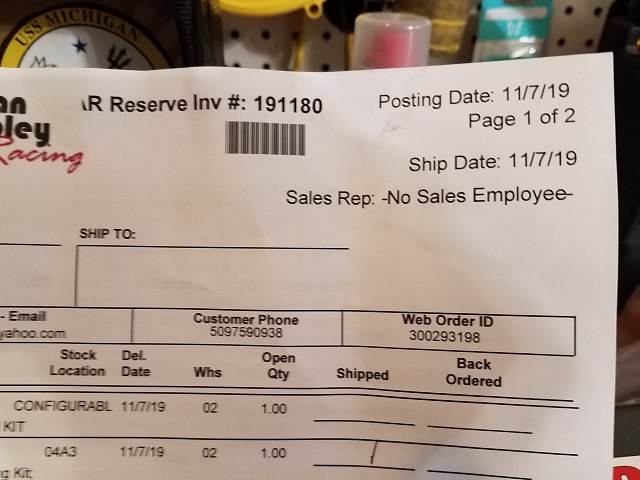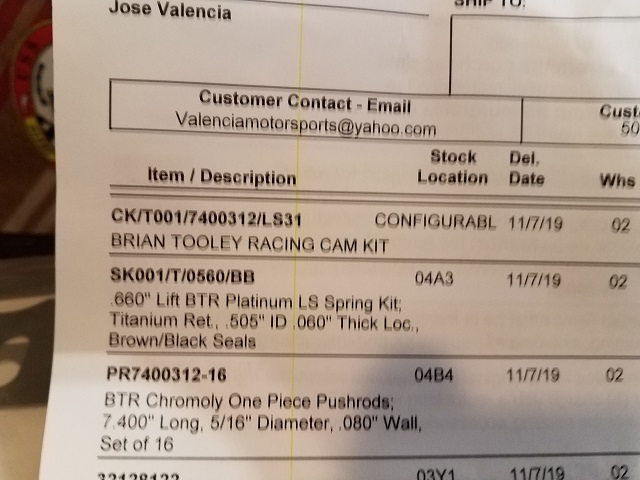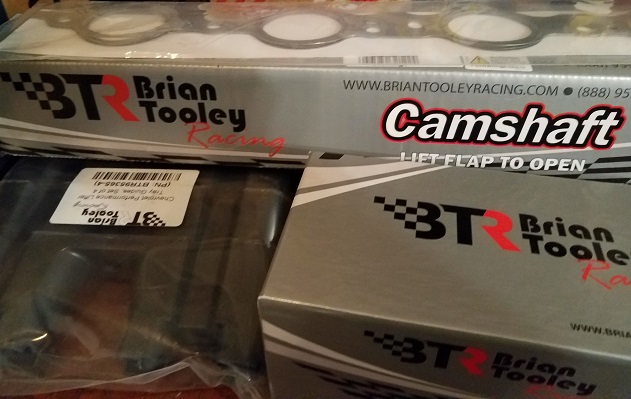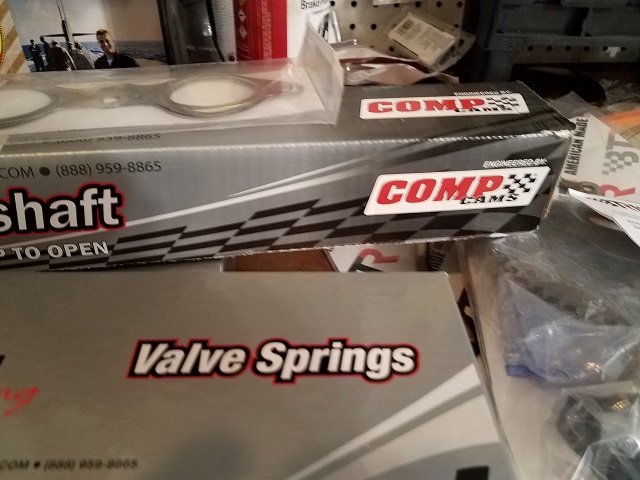- Good Sam Community
- Groups
- Travel Trailer Group
- Forum
- New Ford 7.3 V8
- Subscribe to RSS Feed
- Mark Topic as New
- Mark Topic as Read
- Float this Topic for Current User
- Bookmark
- Subscribe
- Mute
- Printer Friendly Page
New Ford 7.3 V8
- Mark as New
- Bookmark
- Subscribe
- Mute
- Subscribe to RSS Feed
- Permalink
- Report Inappropriate Content
Nov-10-2019 02:33 PM
- Labels:
-
Tow Vehicles
- Mark as New
- Bookmark
- Subscribe
- Mute
- Subscribe to RSS Feed
- Permalink
- Report Inappropriate Content
Nov-13-2019 06:17 PM
FishOnOne wrote:ls1mike wrote:
Just one more I can't let it go, please help me
My 11 second 2000 WS6 Cold start.
Cold start video
Fuel injection is the best. 🙂
Ok I am done.
Looks to be Trans Am with those honey comb tail lights is the tell tail sign of a LS engine under the hood.
Yep 2000 Trans Am WS6. Heads, Cam, intake, headers, Ford 9 inch, Mcleod twin disk clutch and a bunch of other stuff I am forgetting. Dyno tuned at 440 RWHP. It will get out of it's own way. 🙂
68,000 miles, half of those a 1/4 mile at a time. LOL (not really)
2024 Chevy 2500HD 6.6 gas/Allison
2012 Passport 3220 BHWE
Me, the Wife, two little ones and two dogs.
- Mark as New
- Bookmark
- Subscribe
- Mute
- Subscribe to RSS Feed
- Permalink
- Report Inappropriate Content
Nov-13-2019 06:07 PM
ls1mike wrote:
Just one more I can't let it go, please help me
My 11 second 2000 WS6 Cold start.
Cold start video
Fuel injection is the best. 🙂
Ok I am done.
Looks to be Trans Am with those honey comb tail lights is the tell tail sign of a LS engine under the hood.
'16 Sprinter 319MKS "Wide Body"
- Mark as New
- Bookmark
- Subscribe
- Mute
- Subscribe to RSS Feed
- Permalink
- Report Inappropriate Content
Nov-13-2019 05:59 PM
My 11 second 2000 WS6 Cold start.
Cold start video
Fuel injection is the best. 🙂
Ok I am done.
2024 Chevy 2500HD 6.6 gas/Allison
2012 Passport 3220 BHWE
Me, the Wife, two little ones and two dogs.
- Mark as New
- Bookmark
- Subscribe
- Mute
- Subscribe to RSS Feed
- Permalink
- Report Inappropriate Content
Nov-13-2019 05:36 PM
This is for my 2014 Caprice, L77 (6.0 LS2 Bottom end LS3 Heads)
I suspect with this setup and ZL1 Torque convertor the car will make right around 440 to wheels and run mid to low 12s. It is my daily driver.
Notice the date they were ordered. I will be busy this weekend. 🙂
Sorry I highjacked the thread but sometimes guys are stuck in the 60's





2024 Chevy 2500HD 6.6 gas/Allison
2012 Passport 3220 BHWE
Me, the Wife, two little ones and two dogs.
- Mark as New
- Bookmark
- Subscribe
- Mute
- Subscribe to RSS Feed
- Permalink
- Report Inappropriate Content
Nov-13-2019 12:41 PM
Huntindog wrote:ShinerBock wrote:You know you may have a point about hard parts.Huntindog wrote:
As usual, some respond without reading,/comprehending my entire post.
HINT: I said MOST!!
I stand by that statement.
If it doesn't apply to you..... Don't get your panties in a bunch.
BTW..... 797 HP is available stock. No need to even tune it.
I know what you meant, and most people I know who have tuned their own diesel truck also installed hard parts or configured hard parts on their truck in one fashion or another or have a garage do it. In many cases they tune the truck to take advantage of these hard parts. Very few people that I know only tune and that is it. Although, the tuners themselves have to get their hands dirty in the tuning process as well. There is a lot more involved than just hooking up a laptop and doing a remap. Lots of dyno and driving time especially for street driven tunes and even more so for tow tunes.
Tuning a fuel map on an ECM is no different than configuring a carburetor, adjusting timing on a distributor, or replacing a cam. The difference is that these parts were fixed back in the day and could not be adjusted as you are driving. With today's engines, they are not fixed and can be adjusted via the ECM. One of the main reasons why they are adjustable is due to emissions requirements (both gas and diesel) and in many cases power can be added(up too a point) by removing this emissions tuning.
However, you still need to add hard parts to increase power past this point. For N/A engines, you can't get that much added power and will have to start adding hard parts if you want to get any real increase in power over 30hp. For forced induction engines, a lot more power can be had out of the box especially diesels due to how the restrictive the factory tuning is to keep the engine within emission standards. Well over 50hp can be had with FI engines with just tunning.
Most if not all of the tuners I speak do know how to cut the muffler off.
I guess that counts as a hard part. :B
If that is all they know how to do, then they ain't a tuner.
2016 BMW 2.0L diesel (work and back car)
2023 Jeep Wrangler Rubicon 3.0L Ecodiesel
Highland Ridge Silverstar 378RBS
- Mark as New
- Bookmark
- Subscribe
- Mute
- Subscribe to RSS Feed
- Permalink
- Report Inappropriate Content
Nov-13-2019 12:28 PM
ShinerBock wrote:You know you may have a point about hard parts.Huntindog wrote:
As usual, some respond without reading,/comprehending my entire post.
HINT: I said MOST!!
I stand by that statement.
If it doesn't apply to you..... Don't get your panties in a bunch.
BTW..... 797 HP is available stock. No need to even tune it.
I know what you meant, and most people I know who have tuned their own diesel truck also installed hard parts or configured hard parts on their truck in one fashion or another or have a garage do it. In many cases they tune the truck to take advantage of these hard parts. Very few people that I know only tune and that is it. Although, the tuners themselves have to get their hands dirty in the tuning process as well. There is a lot more involved than just hooking up a laptop and doing a remap. Lots of dyno and driving time especially for street driven tunes and even more so for tow tunes.
Tuning a fuel map on an ECM is no different than configuring a carburetor, adjusting timing on a distributor, or replacing a cam. The difference is that these parts were fixed back in the day and could not be adjusted as you are driving. With today's engines, they are not fixed and can be adjusted via the ECM. One of the main reasons why they are adjustable is due to emissions requirements (both gas and diesel) and in many cases power can be added(up too a point) by removing this emissions tuning.
However, you still need to add hard parts to increase power past this point. For N/A engines, you can't get that much added power and will have to start adding hard parts if you want to get any real increase in power over 30hp. For forced induction engines, a lot more power can be had out of the box especially diesels due to how the restrictive the factory tuning is to keep the engine within emission standards. Well over 50hp can be had with FI engines with just tunning.
Most if not all of the tuners I speak do know how to cut the muffler off.
I guess that counts as a hard part. :B
100% boondocking
2021 Grand Design Momentum 398M
2 bathrooms, no waiting
104 gal grey, 104 black,158 fresh
FullBodyPaint, 3,8Kaxles, DiscBrakes
17.5LRH commercial tires
1860watts solar,800 AH Battleborn batterys
2020 Silverado HighCountry CC DA 4X4 DRW
- Mark as New
- Bookmark
- Subscribe
- Mute
- Subscribe to RSS Feed
- Permalink
- Report Inappropriate Content
Nov-13-2019 12:25 PM
So I’m going to call it a “Ford 7.3 flex fuel engine”.
- Mark as New
- Bookmark
- Subscribe
- Mute
- Subscribe to RSS Feed
- Permalink
- Report Inappropriate Content
Nov-13-2019 11:50 AM
While it's still easy to build a decent HP old school GM small block and real easy to build a big HP old school big block, the LS engine line summarily killed the prowess of the old iron small and big blocks.
LS based engines. And LS engines have been around for over 20 years now.
2017 Heartland Torque T29 - Sold.
Couple of Arctic Fox TCs - Sold
- Mark as New
- Bookmark
- Subscribe
- Mute
- Subscribe to RSS Feed
- Permalink
- Report Inappropriate Content
Nov-13-2019 11:03 AM
2024 Chevy 2500HD 6.6 gas/Allison
2012 Passport 3220 BHWE
Me, the Wife, two little ones and two dogs.
- Mark as New
- Bookmark
- Subscribe
- Mute
- Subscribe to RSS Feed
- Permalink
- Report Inappropriate Content
Nov-13-2019 11:01 AM
Huntindog wrote:
I miss the old days. They were IMO, what hot rodding was all about. The Chevy SB had so many possible configurations that one could swap things aroung and build a motor such as the 383... A motor that chevy never produced.
Those were the days when Hot rodders actually got into the inner workings of motors, porting heads, lapping valves, fitting piston rings. installing cams.... Nowadays most just tap on a keyboard and "tune" a motor... The Tuners never get any grease/oil on their hands. Hard to see that as mechanicing... More like playing a video game.
LOL. Come with me on Journey down the road of the LSx. I just ordered all the parts to swap out the Cam in 6.0 Caprice, then I will have to tune it. It requires pulling the heads, new lifters, new valve springs new, valley cover to delete the Displacement on demand. There are plenty of guys doing the same thing you are talking about with the LSx. It is easy and all the parts swap. 5.3 heads on the LS1, 6.0 crank in a 5.3 6.0 in place were a 4.8 was Iron block vs Aluminum block.
My LS1 WS6 has ported stage 2 patriot heads. a 228 232 .581 .592 cam, LS6 intake, Ford 9 inch rearend. All done in my garage, then off for a dyno tune.
Sir I am going to sound like an AS* but you have been out of the game awhile.
2024 Chevy 2500HD 6.6 gas/Allison
2012 Passport 3220 BHWE
Me, the Wife, two little ones and two dogs.
- Mark as New
- Bookmark
- Subscribe
- Mute
- Subscribe to RSS Feed
- Permalink
- Report Inappropriate Content
Nov-13-2019 10:54 AM
dodge guy wrote:
Ok everyone, the big block vs small block debate is ridiculous. Obviously most of you don't know much about engines. The term came from the physical size of the engine, not the displacement!
And if we want we can give the triton motors 3 designations, the 4.6 is a small block, the 5.4 is a big block, and the 6.8 is a bigger block. The physical size of each engine is larger than the next!
This! The big difference between the 4.6 and 5.4 is the 5.4 block is an inch taller tan the 4.6 but it is still a SBF.
In regards to t he LS series of engines.
A 4.8, 5.3, 6.0, 6.2 etc is the same size block with a different stroke and sometimes bore.
6.0 has a 4.0 inch bore while the 4.8 and 5.3 have a 3.78 inch bore.
The original aluminum LS1 was the same size block with a 3.9 inch bore.
LS7 had what I believe to be the largest production bore at 4.25 inches and that is a 427 small block.
There are largest displacement aftermarket LS small blocks. Same size block.
Same physical size, that is why LS swaps are so popular.
2024 Chevy 2500HD 6.6 gas/Allison
2012 Passport 3220 BHWE
Me, the Wife, two little ones and two dogs.
- Mark as New
- Bookmark
- Subscribe
- Mute
- Subscribe to RSS Feed
- Permalink
- Report Inappropriate Content
Nov-13-2019 10:39 AM
BenK wrote:
GM 6.6L is based on the small block. Ref link below
https://www.google.com/amp/gmauthority.com/blog/2019/02/gm-planning-new-engine-larger-than-new-6-6l-...
A small block will most likely never have the duty cycle of a big block...maybe if they spend tons and tons of $$$
Direct injection doesn’t have gasoline washing the intake port and EGR deposits won’t be washed away
Oil sprayed at the piston bottoms a nifty thermal metric
Still love my L29...but if GM comes out with a similar big block...WOW...just might get one
You really need to see the longevity and mileagae a 6.0 gets vs a 7.4. You would be suprised. Tons of guys are doing it now with no 7.4 or 8.1 to offer. I went from a 1989 7.4 to 2002 6.0 to a 2017 6.0. You couldn't give me a 7.4 for free at this point.
2024 Chevy 2500HD 6.6 gas/Allison
2012 Passport 3220 BHWE
Me, the Wife, two little ones and two dogs.
- Mark as New
- Bookmark
- Subscribe
- Mute
- Subscribe to RSS Feed
- Permalink
- Report Inappropriate Content
Nov-13-2019 10:36 AM
Grit dog wrote:
^Yeah GM is still sucking wind in the gas HD truck engines, even with the new 6.6. Maybe they'll be under rated, hopefully.
Except the 6.4 with outgoing 6 speed never out pulled the 6.0 with the 6 speed. It wasn't geared properly and didn't put as much HP to wheels as you thought it should based off of the advertised power the engine made.
It is more about power to wheels and gearing. You can advertise any horse power you want. I want to see real world towing numbers.
2024 Chevy 2500HD 6.6 gas/Allison
2012 Passport 3220 BHWE
Me, the Wife, two little ones and two dogs.
- Mark as New
- Bookmark
- Subscribe
- Mute
- Subscribe to RSS Feed
- Permalink
- Report Inappropriate Content
Nov-13-2019 10:32 AM
Boomerweps wrote:
Jeeze Louise, big block vs. small block V8!
It's not that hard to understand, ladies.
Makers would take existing designs, I.e., the existing engine block, and change its bore or piston stroke length or both to increase displacement and hopefully gain power. So most makers based engine designs on few basic castings, like two sizes, hence big and small block terms. Ford, for example, started with a 260 cu. in. V8 and took that to a 302 small block. 390 and up into the 500s were the big blocks. I THINK the 351 was based on the small block but I'm not sure. In GM's case, small blocks from the factory were 350 cu.in. and below. 396, 427, 502 were based on the same engine block.
For GM that was sort of prior to the last 8.1
You can now get a 527 C.I. LSx based engine which is still a small block.
2024 Chevy 2500HD 6.6 gas/Allison
2012 Passport 3220 BHWE
Me, the Wife, two little ones and two dogs.





